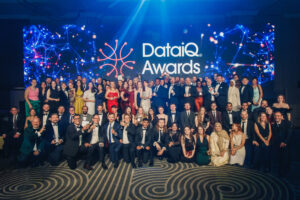Accenture has been a longstanding partner of DataIQ, sponsoring the DataIQ 100 Europe and DataIQ 30 Africa in 2025.
Questions Explored
- What does the CEO now expect from the CDO?
- How can data leaders create enterprise agency rather than more analytics?
- Why do incentive structures matter more than strategy decks?
- How do CDOs move from pilots to profit?
- What keeps trust at the centre of AI-driven transformation?
“You’re the force multiplier for the CEO, the ones who’ll drive agency and adoption. Get that right, and you’ll move from pilots to profits.” – Matt Prebble, CEO, Accenture UK, Ireland & Africa
Agency over intelligence
Intelligence matters less than agency was Matt’s central argument. Drawing on a reflection by AI thinker Andrej Karpathy, he said, “Agency is significantly more powerful and significantly more scarce.”
For Matt, that mindset defines the next chapter of data leadership: “People with high agency don’t just let life happen to them, they shape it,” he said. The CDO’s job, therefore, is to infuse that agency across the enterprise, driving execution rather than commentary.
He signalled that the strategic window for influence is wider than ever, stating: “The trillion-dollar bet on AI and data has already been made… Everything’s stacked in your favour at the moment.” The question now is who inside the enterprise will turn that investment into impact, with Matt explaining that the CDO must sit alongside the CEO as the force multiplier of agency and execution.
When incentives trump intentions
The biggest barrier to data transformation are misaligned incentives and not technology. “I can’t emphasise enough the importance of aligning incentive structures across the organisation,” he said.
He pointed to examples where the CDO sits on the main board and every executive’s remuneration links to data performance. For Matt, this integration of data into the financial architecture of the enterprise turns digital ambition into accountability.
For CDOs, the lesson is to design leverage, not reports. When the incentives change, culture follows.
People as the last competitive advantage
Matt argued that people remain the true differentiator. “For most of you, people will continue to be the advantage,” he said.
He used his own firm as the test case: “’Our close to 800,000 people are our greatest advantage as a firm – empowering them with AI is how we power this advantage over the next decade.”
The implication is strategic: the CDO’s role now extends beyond governance to workforce enablement creating the conditions for thousands to act with intelligence and initiative.
Integration as the new product
Speed, Matt warned, is lost not in innovation but gets lost in integration. “The single biggest factor that slows you down once you’re into production is the pace of integration across people, process, technology.”
His message: treat integration as a product. Set up product teams to challenge integration the biggest determinant of success.
By framing it in this way, it shifts integration from an operational drag to a design problem. For CDOs, it’s a reminder that data leadership is as much about orchestration as architecture.
Centres of Execution
Matt underlined that too many organisations mistake experimentation and pilots for progress: “Those centres of excellence need to move to centres of execution.” For example, a mature CDO organisation does not wait to be consulted as they are the ones that drive cross-enterprise delivery. It must be noted that AI continues to operate middle-to-middle, and the successful organisations are the ones that invest the time to get the end-to-end flow, not just the middle.
The challenge is to re-engineer how AI meets process, shifting it from proof-of-concept to proof-of-impact.
Reinvention beats pilots
Matt noted that securing AI investment is not the hurdle it has been in recent years: “The budget for data is much more straightforward today than five or ten years ago.” The real test for CDOs is showing impact in customer terms.
He recounted a case where Accenture simulated customer journeys with generative AI to reveal margin shifts and behaviour change: “Within 48 hours we were in front of the CEO talking about the implications of the business.”
He also urged data and AI leaders to turn their attention to leveraging generative and agentic AI to redesign, not just rely on automating existing processes. Matt warned that process reinvention beats pilots, and automating broken processes just leads to automated micro processes.
Defining what makes you different
Every CEO needs clarity on the enterprise’s “secret sauce”, or the data and processes that truly drive advantage. “The CDO and CIO must co-define what makes the difference,” Matt said.
He cited previous work with a company that codified its unique know-how into what was described as a “intelligent digital brain.” “They got clarity around what makes them different, and they codified it in a way that resonated with the board,” said Matt.
A long-term roadmap, anchored in trust
If the last decade was about adoption, Matt believes the next will be about endurance. “We’re seeing CEOs understand this is a longer-term journey,” he said. “It’s going to happen over multiple years.”
Yet the foundation remains trust, not only in data but in how organisations use AI. The stark warning was “if trust disappears, the whole model breaks down.”
The takeaway is cultural as much as operational: sustained transformation depends on credible stewardship. Trust, not capability, will decide which enterprises earn the right to lead.
Practical Learnings
- Reposition the CDO as the CEO’s multiplier; become the bridge between ambition and execution.
- Engineer incentives that tie data outcomes to board-level accountability.
- Invest in people, making AI fluency and agency core to enterprise capability.
- Design for integration, treating it as a continuous product, not a one-off project.
- Move from pilots to process reinvention that delivers measurable value.
- Clarify your differentiation by identifying and codifying the “secret sauce” of your data advantage.
- Build for trust, embedding transparency and ethical use of AI into business design.





